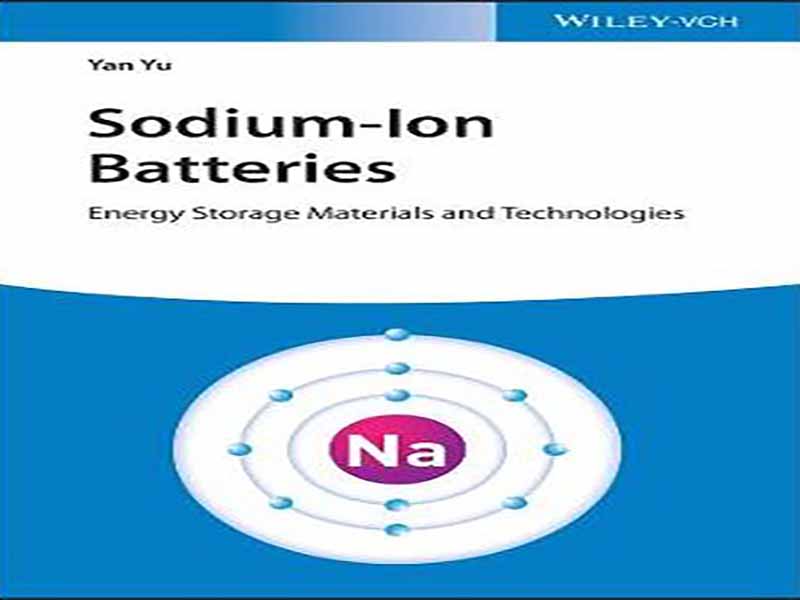- عنوان کتاب: Sodium-Ion Batteries / Energy Storage Materials and Technologies
- نویسنده: Yan Yu
- حوزه: باتری
- سال انتشار: 2022
- تعداد صفحه: 542
- زبان اصلی: انگلیسی
- نوع فایل: pdf
- حجم فایل: 23.4 مگابایت
بهره برداری و استفاده بیش از حد از سوخت های فسیلی باعث کاهش سریع منابع طبیعی و مجموعه ای از مسائل زیست محیطی مانند آب و هوای شدید و اثر گلخانه ای شده است. با بیدار شدن آگاهی عمومی از محدود بودن منابع زمین، منابع انرژی تجدیدپذیر (مانند خورشید، باد، جزر و مد و غیره) به عنوان جایگزین توسعه یافته اند. در حالی که ماهیت متناوب این منابع انرژی نیازمند سیستمهای ذخیرهسازی انرژی کارآمدتر است. در طول 30 سال گذشته، فناوری باتریهای لیتیوم یون (LIBs) با پیشرفت بینظیری پیشرفت کرده است و اکنون بر بازار دستگاههای الکترونیکی قابل حمل و وسایل نقلیه الکتریکی تسلط یافته است. در حالی که با کاهش ذخایر مواد خام، افزایش قیمت LIB پیش بینی می شود. باتریهای یون سدیم (SIB) از فناوریهای الکتروشیمی و ساخت مشابه با LIB بهره میبرند، در حالی که با هزینه کم و ایمنی بهتر به دلیل منابع سدیم فراوان، آنها را به جایگزینی امیدوارکننده برای LIB در ذخیرهسازی انرژی در مقیاس بزرگ تبدیل میکند. در طول سال های گذشته، تعداد زیادی از کارهای تحقیقاتی به توسعه و تجاری سازی SIB ها اختصاص یافته است. پیشرفتهای خوشحالکنندهای حاصل شده است و از سوی دیگر، هنوز تلاشهای بیشتری برای رسیدگی به مسائل مشکلساز حلنشده مورد نیاز است. این کتاب در نظر دارد به محققان و دانشجویان فارغ التحصیل/کارشناسی در زمینه های مرتبط علم مواد و الکتروشیمی تصویری از تلاش های جاری در بهبود فناوری SIB ارائه دهد و همچنین راه را برای توسعه نسل جدیدی از چگالی انرژی بالاتر هموار کند. SIB های قابل شارژ از طریق بهینه سازی جامع در مواد الکترود، الکترولیت ها و سایر اجزای کلیدی. فصل های 1 و 2 مقدمه ای اساسی (شامل تاریخچه، اصل عملیات، مواد کلیدی و غیره) برای SIB ها ارائه می دهند، همچنین برخی از اصول طراحی را از نظر چگالی انرژی، چگالی توان، عمر دوچرخه سواری و ایمنی برای ساخت SIB های با کارایی بالا بیان می کنند. فصل های 3 تا 6 به طور سیستماتیک مواد کاتدی اکسیدهای فلزات واسطه، ترکیبات پلی آنیونی، آنالوگ های آبی پروس و ترکیبات آلی برای SIB ها را از نظر طراحی ساختاری، خواص الکتروشیمیایی و مکانیسم های واکنش مربوطه معرفی می کنند. از فصل 7 تا فصل 10، مواد آند از نوع درونیابی (مواد مبتنی بر کربن، مواد مبتنی بر تیتانیوم و غیره)، مواد آند آلیاژی و تبدیلی (فلزات/آلیاژهای فلز، اکسیدهای فلزی/کلکوژنیدهای فلزی، فسفر/فسفیدها) و غیره)، و آندهای فلزی Na توضیح داده شده است. الکترولیت ها شامل الکترولیت های مایع آلی، الکترولیت های مایع یونی و الکترولیت های جامد در فصل های 11 تا 13 ذکر شده اند. علاوه بر این، بایندر نیز بخش مهمی از SIB ها است و پیشرفت آن در فصل 14 خلاصه شده است. برای کاربردهای عملی، سه نوع سدیم- باتریهای کامل یونی (SIFB) شامل SIFBهای غیرآبی، آبی و تمام حالت جامد در فصل 15 مورد بحث قرار گرفتهاند. و آخرین فصل 16 دیدگاههایی در مورد فرصتها و مزایای بالقوه SIB برای ذخیرهسازی انرژی در مقیاس بزرگ ارائه میدهد. در نهایت، من با سپاس از کمک قابل توجه پروفسور یانگلونگ هو، پروفسور شیائوگانگ ژانگ، پروفسور شیان هونگ روئی، پروفسور هونگفا شیانگ، دکتر لینا ژائو، پروفسور یوان-لی دینگ، پروفسور چانگبائو ژو، پروفسور لایفا شن قدردانی می کنم. ، پروفسور Jianmin ما، پروفسور Feixiang وو، پروفسور Xuyong Feng، دکتر دان یانگ، دکتر Xianghua ژانگ، و دکتر وی لو به این کتاب.
Excessive exploitation and use of fossil fuels have caused rapid reduction of the natural resources and a series of environmental issues such as extreme weather and greenhouse effect. With the awakened public awareness of the finiteness of the earth’s resources, the renewable energy sources (e.g. solar, wind, tide, etc.) are developed as alternatives. While the intermittent character of these energy sources calls for more efficient energy storage systems. Over the past 30 years, lithium-ion batteries (LIBs) technology has advanced with unparalleled progress and is now dominating the market in portable electronic devices and electric vehicles. While with dwindled reserves of the raw materials, a rise in LIB price is foreseen. Sodium-ion batteries (SIBs) share similar electrochemistry and fabrication technologies to LIBs while featuring with low cost and better safety due to earthabundant sodium resources, rendering them a promising alternative to LIBs in large-scale energy storage. Over the past years, a wealth of research works has been dedicated to the development and commercialization of SIBs. There has been gratifying progress achieved and on other hand, urged greater efforts are still needed to address the unresolved troubling issues. This book intends to provide researchers and graduate/undergraduate students in related fields of materials science and electrochemistry with a snapshot of current efforts in improving the SIB technology, as well as pave the way for the development of a new generation of higher-energy density, rechargeable SIBs through comprehensive optimization in electrode materials, electrolytes, and other key components. Chapters 1 and 2 provide a basic introduction (including history, operation principle, key materials, etc.) to SIBs, as well as outline some design principles in terms of energy density, power density, cycling life, and safety to build highperformance SIBs. Chapters 3 to 6 systematically introduce the cathode materials of transition metal oxides, polyanionic compounds, Prussian blue analogues, and organic compounds for SIBs, in terms of structural design, electrochemical properties, and the corresponding reaction mechanisms. From Chapter 7 to Chapter 10, intercalation-type anode materials (carbon-based materials, titanium-based materials, etc.), alloy- and conversion-type anode materials (metals/metal alloys, metal oxides/metal chalcogenides, phosphorous/phosphides, etc.), and Na metal anodes are described. Electrolytes including organic liquid electrolytes, ionic liquid electrolytes, and solid electrolytes are mentioned in Chapters 11 to 13. Besides, binder is also an important part of SIBs, and its progress is summarized in Chapter 14. For practical applications, three types of sodium-ion full batteries (SIFBs) including non-aqueous, aqueous, and all-solid-state SIFBs are discussed in Chapter 15. And, the last Chapter 16 gives perspectives on the opportunities and potential benefits of SIBs for large-scale energy storage. Finally, I gratefully acknowledge the substantial contribution from Prof. Yanglong Hou, Prof. Xiaogang Zhang, Prof. Xianhong Rui, Prof. Hongfa Xiang, Dr. Lina Zhao, Prof. Yuan-Li Ding, Prof. Changbao Zhu, Prof. Laifa Shen, Prof. Jianmin Ma, Prof. Feixiang Wu, Prof. Xuyong Feng, Dr. Dan Yang, Dr. Xianghua Zhang, and Dr. Wei Luo to this book.
این کتاب را میتوانید از لینک زیر بصورت رایگان دانلود کنید:
Download: Sodium-Ion Batteries




































نظرات کاربران